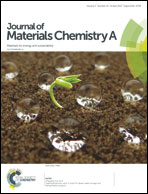A new Ce-doped MgAl-LDH@Au nanocatalyst for highly efficient reductive degradation of organic contaminants†
Abstract
A new type of convenient, environmentally friendly, and recyclable nanocatalyst (abbreviated as MgAlCe-LDH@Au) was designed and successfully assembled by loading Au nanoparticles (Au NPs; ∼3 nm average diameter) on a MgAlCe-LDH support through an in situ reduction of HAuCl4 by NaBH4. The MgAlCe-LDH support was prepared by doping the Magnesium–Aluminum Layered Double Hydroxide (MgAl-LDH) with cerium ions. The obtained MgAlCe-LDH@Au nanocatalyst was fully characterized by conventional methods and possesses excellent properties, such as a narrow size distribution, a high structural stability, a large specific surface area, and a good distribution of the Au NPs. Besides, this nanocatalyst displays a very remarkable activity in the reductive degradation of 4-nitrophenol by NaBH4 with a rate constant (kapp) of 0.041 s−1 and a catalyst turnover frequency (TOF) of 1.2 × 106 h−1; the reactions proceed in aqueous medium at room temperature and atmospheric pressure. The MgAlCe-LDH@Au nanocatalyst can also be recycled, maintaining its original activity even after seven consecutive reaction cycles. Additionally, MgAlCe-LDH@Au is a highly efficient catalyst for the reductive degradation (discoloration) of common organic dyes, including methylene blue, methyl orange, Congo red, rhodamine B, and rhodamine 6G, resulting in up to 3.2 × 104 h−1 values of TOFs. For comparative purposes, a related Ce-free MgAl-LDH@Au material was assembled and tested as the catalyst. The superior activity of MgAlCe-LDH@Au over MgAl-LDH@Au or MgAlCe-LDH can be explained by the following factors: (1) LDH itself can act as a co-catalyst and the doping of MgAl-LDH with cerium ions increases the charge separation efficiency of surface electrons; (2) Ce ions can strongly interact with Au atoms, modifying their electronic structure, stabilizing the oxidation states, and enhancing the fixation of Au NPs and their dispersion. Furthermore, the achieved catalytic activity of the MgAlCe-LDH@Au nanocatalyst is significantly superior when compared with other state-of-the-art systems for the degradation of similar types of organic contaminants.



 Please wait while we load your content...
Please wait while we load your content...